If you’re looking to boost your UX skills, I recommend starting with foundational books like *The Elements of User Experience* and exploring practical guides on measuring and analyzing user data. Techniques in user research, storytelling, and sketching will deepen your understanding, while resources like *Web Style Guide* provide design principles. Choosing the right titles depends on your goals and experience level—keep exploring, and you’ll uncover more valuable insights to elevate your design game.
Key Takeaways
- The list includes foundational UX books like *The Elements of User Experience* for beginners and deep dives into design principles.
- It features books on quantitative research, such as *Measuring the User Experience*, to improve data-driven decision making.
- Practical technique guides like *Sketching User Experiences* and storytelling books enhance hands-on skills and user insights.
- Resources like *Laws of UX* and *Web Style Guide* provide quick reference laws and best practices for ethical, effective design.
- The selection balances theory, research, storytelling, and technical guidance to elevate overall user experience and design skills.
The Elements of User Experience Book (2nd Edition)

Are you new to user experience design and looking for a clear, straightforward introduction? The Elements of User Experience (2nd Edition) by Jesse James Garrett is perfect for beginners. It breaks down complex concepts into simple, visual models that make understanding UX easy. The book combines theory with practical examples, including diagrams and case studies, to help you grasp the process. Its logical structure and engaging layout make it accessible for students and professionals alike. Think of it as your foundational guide—clarifying the core principles of user-centered design and giving you tools to communicate and develop better, user-friendly products confidently.
Best For: beginners, students, and professionals seeking a clear, visual, and foundational introduction to user experience design.
Pros:
- Provides a concise, well-structured overview of core UX principles suitable for newcomers.
- Uses visual models, diagrams, and case studies to simplify complex concepts and enhance understanding.
- Highly accessible and engaging layout, making it easy to reference and comprehend for a wide audience.
Cons:
- Lacks in-depth examples of interaction planning and detailed project scope or strategy discussions.
- Focuses more on frameworks and concepts rather than detailed documentation practices.
- May require supplementary resources for advanced UX techniques or technical implementation details.
Measuring User Experience: UX Metrics

If you’re a UX professional or researcher looking to deepen your understanding of how to measure user experience effectively, “Measuring the User Experience: Collecting, Analyzing, and Presenting UX Metrics” stands out as an essential resource. This book is praised for its clarity, efficient explanations, and practical content, making complex concepts accessible. Written by top experts, it covers a wide range of topics on collecting, analyzing, and presenting UX data. You can apply what you learn immediately to your projects, enhancing your research skills and improving user experience evaluation across various interactive technologies.
Best For: UX professionals and researchers seeking a clear, practical guide to measuring and analyzing user experience effectively.
Pros:
- Highly praised for clarity, efficiency, and valuable content.
- Written by top experts, providing well-structured and accessible insights.
- Offers practical techniques that can be applied immediately to improve UX research skills.
Cons:
- May require some prior knowledge of UX concepts for full comprehension.
- Focuses primarily on measurement techniques, potentially less on broader UX design strategies.
- As a technical resource, it might be dense for newcomers without background in research methods.
User Experience Research: Discover What Customers Really Want
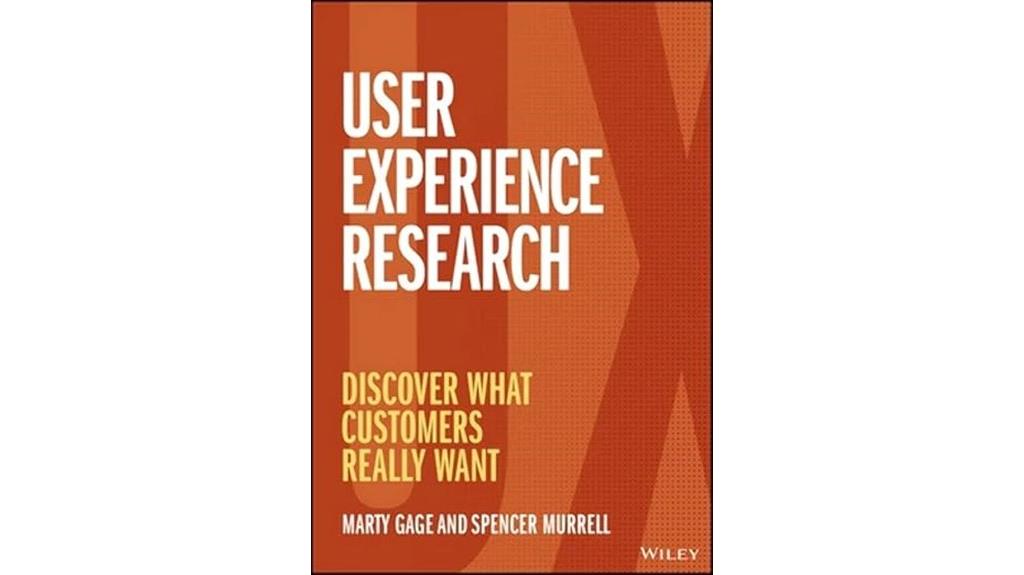
Anyone involved in designing or researching user experiences will find “User Experience Research” by Marty Gage and Spencer Murrell an invaluable resource. It offers practical guidance for uncovering what customers truly want through proven methods like observational studies and experience collages. The book covers the entire research process, from targeting users to analyzing qualitative data and storytelling. Its high-level, well-structured content helps both beginners and seasoned professionals refine their skills. With visual aids and real-world examples, it encourages experimentation and deepens understanding of user motivations, making it an essential tool for creating meaningful, emotionally resonant experiences.
Best For: professionals, educators, and students involved in designing, researching, or innovating with user experiences who seek comprehensive guidance and practical methods to understand customer needs and motivations.
Pros:
- Provides clear, high-level guidance suitable for both beginners and experienced researchers.
- Incorporates visual aids, real-world examples, and practical tools to enhance understanding and application.
- Emphasizes experimentation and innovative frameworks to deepen insights into user emotions and motivations.
Cons:
- May require some foundational knowledge in research methods for full comprehension.
- Focuses primarily on qualitative research, potentially limiting coverage of quantitative analysis techniques.
- The breadth of content can be overwhelming for those looking for highly specific or technical methodologies.
Laws of UX: Using Psychology to Design Better Products & Services
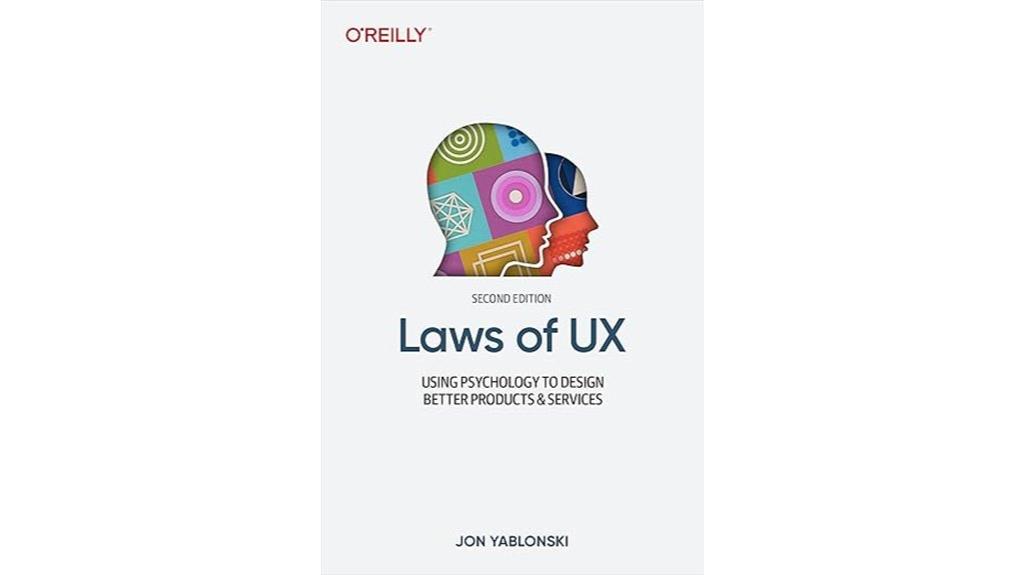
For those enthusiastic to deepen their understanding of how psychological principles influence user interface design, “Laws of UX: Using Psychology to Design Better Products & Services” offers a compelling starting point. This well-crafted book appeals to both beginners and experts, presenting clear laws, principles, and guidelines that apply across various contexts. It features engaging visuals, updated examples, and a logical structure that makes complex ideas accessible. I find it invaluable for improving design decisions ethically, understanding user behavior, and avoiding common pitfalls. Whether you’re studying UX or seeking a practical reference, this book is a must-have to elevate your skills and craft more user-centered products.
Best For: beginners and experts in UI/UX design seeking a clear, practical guide to psychological principles and ethical design strategies.
Pros:
- Provides clear, well-organized laws and principles applicable across various design contexts.
- Features engaging visuals, updated examples, and detailed explanations that enhance understanding.
- Serves as a valuable reference for ethical user-centered design and ongoing professional development.
Cons:
- Some readers find the print quality to be only slightly better than a newspaper, impacting readability.
- Could include more practical guidelines and evaluation criteria to complement the laws.
- The structure, while logical, may require some effort to fully apply in complex or highly specific projects.
Quantitative User Experience Research
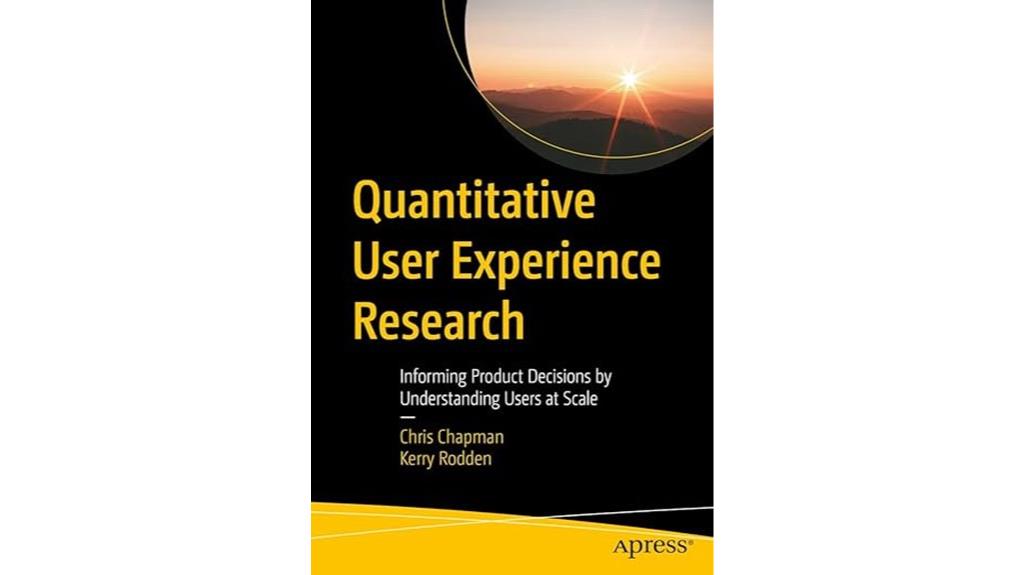
Quantitative User Experience Research stands out as an essential resource for practitioners who want to apply data-driven methods in real-world industry settings. This book emphasizes practical application over technical detail, guiding you on when, why, and how to use quantitative methods effectively. It addresses common challenges faced during implementation and offers pragmatic advice tailored for tech companies. Whether you’re new to the field or experienced, it helps clarify how quantitative research impacts product decisions and supports career growth. I found it especially valuable for expanding my statistical skills and understanding how to combine qualitative and quantitative insights for more rigorous, impactful research.
Best For: practitioners, researchers, and managers seeking practical, real-world guidance on applying quantitative user experience research methods to drive product decisions and career growth.
Pros:
- Emphasizes practical application over complex technical details, making it accessible for diverse experience levels
- Offers real-world insights and pragmatic advice tailored for industry settings, especially tech companies
- Supports career development by clarifying how to expand quantitative skills and integrate mixed methods research
Cons:
- May lack in-depth technical explanations for those seeking advanced statistical methodologies
- Focused primarily on industry application, with less emphasis on academic or theoretical aspects
- Could be less suitable for readers looking for comprehensive statistical training or detailed methodological frameworks
Storytelling for User Experience by Whitney Quesenbery and Kevin Brooks

If you’re looking to strengthen your storytelling skills to improve user experience, “Storytelling for User Experience” by Whitney Quesenbery and Kevin Brooks offers practical guidance suitable for all experience levels. This book highlights how storytelling enhances UX, usability, and design, providing real-life examples, exercises, and strategies to craft compelling narratives. It teaches you to listen, observe, and transform user insights into stories that reveal frustrations, motivations, and successes. These stories help prioritize features, identify usability issues, and communicate effectively with teams and stakeholders. A valuable resource for anyone wanting to make data more memorable and their designs more user-centered.
Best For: UX designers, researchers, product managers, and anyone interested in enhancing their storytelling skills to improve user experience and communication.
Pros:
- Provides practical exercises and real-life examples that make storytelling techniques accessible and actionable.
- Emphasizes the importance of listening and observing users to craft authentic and compelling narratives.
- Enhances team collaboration and stakeholder buy-in by transforming data into engaging stories that highlight user needs and usability issues.
Cons:
- Some users may find the pricing, especially for color printing, to be high or excessive.
- The book may be less detailed for those seeking advanced storytelling or narrative development techniques.
- As a practical guide, it may require additional application or adaptation for complex or highly technical projects.
Introduction to Design Thinking for UX Beginners

Introduction to Design Thinking for UX Beginners is an ideal starting point for anyone new to user experience design who wants a clear, practical overview of the core concepts. It breaks down complex methodologies into five easy steps, focusing on understanding user needs, motivations, and creating engaging digital experiences. The book emphasizes empathy, continuous learning, and a growth mindset, encouraging readers to think critically and stay updated with industry trends. Filled with real-world examples from companies like Amazon and Microsoft, it offers practical guidance on user research, personas, and journey mapping—making it a valuable foundation for building a successful UX career.
Best For: beginners in UX design seeking a clear, practical introduction to core concepts and methodologies.
Pros:
- Provides a straightforward, accessible overview of UX and design thinking.
- Includes real-world examples from major companies like Amazon and Microsoft.
- Emphasizes practical tools such as user research, personas, and journey mapping.
Cons:
- May lack in-depth technical details for advanced UX practitioners.
- Focuses primarily on foundational concepts, possibly oversimplifying complex topics.
- Limited coverage of specific tools and software used in current UX workflows.
Sketching User Experiences: The Workbook
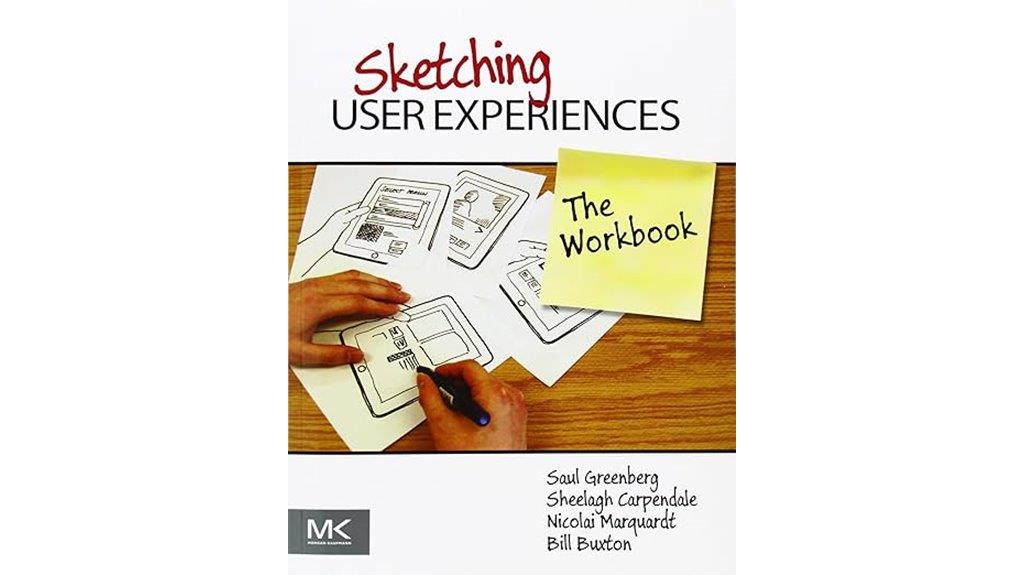
“Sketching User Experiences: The Workbook” is an ideal choice for UX/UI professionals, students, and educators who want to develop hands-on sketching skills for designing and communicating user interfaces. This practical guide emphasizes exercises that move beyond theory, covering fundamental techniques to advanced methods like hybrid sketches and physical prototypes. Each activity includes clear instructions and relevance to user-centered design, making it flexible and accessible. The workbook encourages tactile, visual exploration, helping users craft ideas quickly and effectively. Whether you’re new to UX or looking to refine your skills, this book offers actionable techniques to improve your ability to sketch, communicate, and iterate on user experiences.
Best For: UX/UI professionals, students, and educators seeking practical, hands-on techniques to improve their sketching and communication skills in user experience design.
Pros:
- Emphasizes tactile and visual exploration with easy-to-follow exercises.
- Suitable for learners at all levels, from beginners to experienced practitioners.
- Provides clear instructions and real-world methods to enhance sketching and prototyping skills.
Cons:
- May be too basic or introductory for seasoned UX designers seeking advanced content.
- Focuses more on practical techniques than on underlying design principles.
- Heavily emphasizes physical sketching over digital tools, which might not suit all workflows.
Web Style Guide, 4th Edition: Foundations of User Experience Design
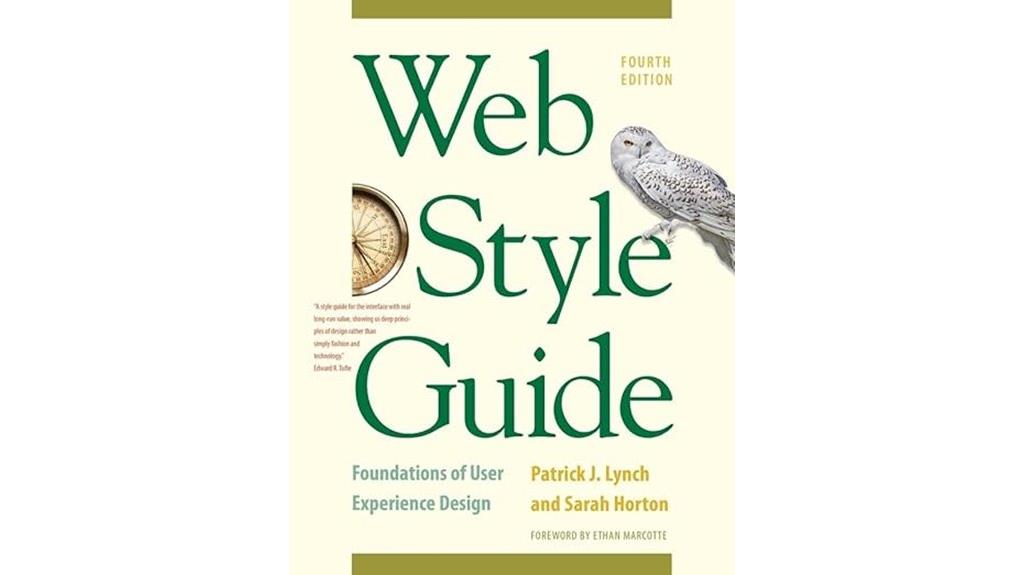
Are you looking for a thorough resource that bridges design principles with real-world web development? The Web Style Guide, 4th Edition, is exactly that. It offers extensive insights into user experience, covering everything from typography to technological trends like retina displays. This guide connects traditional design with web-specific challenges, making it useful for designers, developers, and non-technical team members alike. Its clear language and practical approach help you understand how innovation influences style and layout. Despite some outdated content on images and video, the book remains a crucial reference for maintaining timeless, adaptable web design principles in a constantly evolving digital landscape.
Best For: web designers, developers, editors, and non-technical team members seeking a comprehensive, practical guide to user experience and web design principles.
Pros:
- Offers in-depth insights bridging traditional design concepts with web-specific challenges.
- Written in clear, accessible language suitable for both beginners and experienced professionals.
- Serves as a reliable, enduring reference that emphasizes timeless web design principles amidst technological change.
Cons:
- Some content, particularly on images and video, became outdated by 2021.
- Minor issues such as typos in digital editions and lack of page numbers.
- Requires ongoing updates to stay current with rapidly evolving web technologies.
Factors to Consider When Choosing User Experience Books

When selecting a user experience book, I consider how well it aligns with my goals and the depth of knowledge I need. I also look for practical insights that I can apply directly to my projects, ensuring the content suits my experience level. finally, I pay attention to the book’s layout and visuals, as clarity and readability make learning much easier.
Relevance to Goals
Choosing the right user experience book hinges on how well its content aligns with your specific goals. I look for books that match my learning objectives, whether that’s usability principles, research methods, or design strategies. It’s important to check if the book covers the latest industry trends and technological advancements relevant to my work. I also consider whether it emphasizes practical application or theoretical understanding, depending on how deep I want to go. Knowing who the target audience is helps ensure the complexity level suits my current skills. Finally, I evaluate if the book includes case studies, examples, or exercises that directly support my professional or educational objectives. A well-aligned book saves time and accelerates my growth in user experience.
Depth of Content
Deep user experience books provide extensive coverage of core topics like research methods, design principles, and evaluation techniques, giving me a thorough understanding of the field. They often include detailed case studies, data analysis techniques, and advanced frameworks, perfect for mastering complex concepts. These books are typically dense and require a solid foundation in UX or related disciplines to fully grasp the material. They serve as valuable reference materials or textbooks, supporting ongoing learning and tackling specialized projects. The richness of detail allows exploration of nuanced subjects such as psychological influences, quantitative metrics, and strategic planning. When choosing these books, I consider my current knowledge level and whether I’m ready to engage with in-depth content that pushes my understanding further.
Practical Application Focus
Practical application is a key aspect to contemplate when selecting user experience books, especially if I want to translate theory into real-world results. I look for books that include practical exercises, case studies, or real-world scenarios, as these help me apply UX principles effectively. Step-by-step guidance on methods like user research, design iteration, and usability testing is essential—these make complex concepts actionable. I also prioritize titles that offer tools, templates, or frameworks I can directly incorporate into my workflows, saving time and effort. Hands-on techniques trump purely conceptual content because they develop my skills more robustly. Additionally, I check if the book discusses UX metrics and evaluation methods to ensure my designs are measurable and impactful, making my work both practical and results-driven.
Audience Suitability
When selecting user experience books, I consider the reader’s experience level to guarantee the content matches their knowledge and skill set. Beginners need clear explanations, foundational concepts, and accessible language, while advanced practitioners seek in-depth analysis, complex case studies, and specialized techniques. I also match the book’s focus—whether on research methods, design principles, or storytelling—to fill specific skill gaps. The format matters too; some prefer practical workbooks, others benefit from theoretical overviews or reference guides. Additionally, I check if the content aligns with the industry context—digital, physical, or web design—so the knowledge applies to their field. Ensuring the language and complexity are appropriate helps the reader absorb and implement the insights effectively.
Visual Clarity & Layout
Choosing a user experience book with a clear and well-structured layout makes a considerable difference in how easily I can grasp complex concepts. A good layout features clear headings, subheadings, and logical flow, making the content more accessible. Visual aids like diagrams, models, and illustrations help clarify abstract ideas and demonstrate practical applications effectively. Consistent typography, spacing, and color schemes create a visually appealing design that reduces cognitive load and keeps me focused. An uncluttered layout allows for easy scanning, especially when I need to reference specific sections or diagrams quickly. Visual hierarchy—using size, contrast, and positioning—guides my attention to the most important content, supporting better understanding. Overall, layout and clarity substantially enhance my learning experience.
Have you ever wondered how much an author’s background influences the reliability of a user experience book? I believe it plays a vital role. An author with solid industry experience, such as leadership roles or research contributions, offers deeper insights grounded in real-world practice. Credentials like academic degrees or involvement in UX standards bolster their authority, making their advice more trustworthy. Recognized thought leaders or practitioners who actively publish or speak at industry events tend to provide validated content. Additionally, authors involved in UX communities stay current with the latest trends and best practices, which adds to their credibility. When choosing a book, considering an author’s reputation helps guarantee the information is reliable, relevant, and less likely to be outdated or inaccurate.
Up-to-Date Information
How can you guarantee a user experience book stays relevant in a rapidly evolving field? The key is to look for books that include recent case studies, examples, and references reflecting current UX trends and technologies. Check publication dates and edition updates to ensure the content aligns with the latest developments. Seek out titles that discuss emerging topics like AI, voice interfaces, and mobile-first design to stay ahead. Verify if the book addresses recent industry standards, tools, and best practices for practical relevance. Additionally, reviews and recommendations from recent sources can help confirm whether the information remains accurate and useful. Staying current means actively choosing books that adapt alongside the ever-changing landscape of user experience design.
Frequently Asked Questions
Which Book Is Best for Beginner UX Designers?
I recommend starting with “Don’t Make Me Think” by Steve Krug. It’s perfect for beginners because it simplifies UX principles and offers practical insights without overwhelming jargon. I found it straightforward and engaging, making complex concepts easy to grasp. If you’re new to UX, this book provides a solid foundation and helps you understand user-friendly design fundamentals quickly. It’s an essential read to kickstart your UX journey confidently.
How Do I Choose the Right UX Book for My Needs?
Think of choosing the right UX book like finding the perfect pair of shoes—you need comfort, fit, and style. I recommend starting by identifying your skill level and goals, then picking books that match those needs. Look for clear, practical advice if you’re new, or deeper theories if you’re experienced. Read reviews and sample chapters to see if the style resonates with you. Trust your instincts and pick what feels right for your growth.
Are There Books Focusing on Mobile UX Design?
Yes, there are fantastic books specifically on mobile UX design. I recommend “Mobile First” by Luke Wroblewski, which offers practical insights on designing for mobile devices. “Designing Mobile Interfaces” by Steven Hoober and Eric Berkman is also excellent for understanding mobile interaction patterns. These books help me focus on creating seamless, engaging experiences for mobile users, ensuring my designs are intuitive and user-friendly.
Can These Books Help With UX Project Management?
Absolutely, these books can help with UX project management. I used them myself to better understand team collaboration, timelines, and stakeholder communication. They offer valuable insights beyond just design, helping you lead projects effectively. I know some might think they’re only for designers, but I found they provide practical tips for managing the entire UX process. Give them a try; they really boost your project management skills.
Do Any of These Books Cover Accessibility in UX?
Yes, some of these books do cover accessibility in UX. I’ve found that titles like “Don’t Make Me Think” and “Designing for Accessibility” provide practical insights on creating inclusive, user-friendly designs. They emphasize understanding diverse user needs and accessible design principles. If accessibility is a priority for you, I recommend focusing on books that explicitly address these topics, as they’ll equip you with essential skills to make your designs more inclusive.
Conclusion
These books offer a wealth of knowledge, blending theory with practice. While some focus on metrics and research, others emphasize psychology and design thinking. Together, they remind me that great user experiences aren’t just about visuals—they’re about understanding people deeply. As you explore these titles, remember: mastering UX isn’t just about tools, but about connecting with users on a human level. Aim for balance, and your designs will truly resonate.










